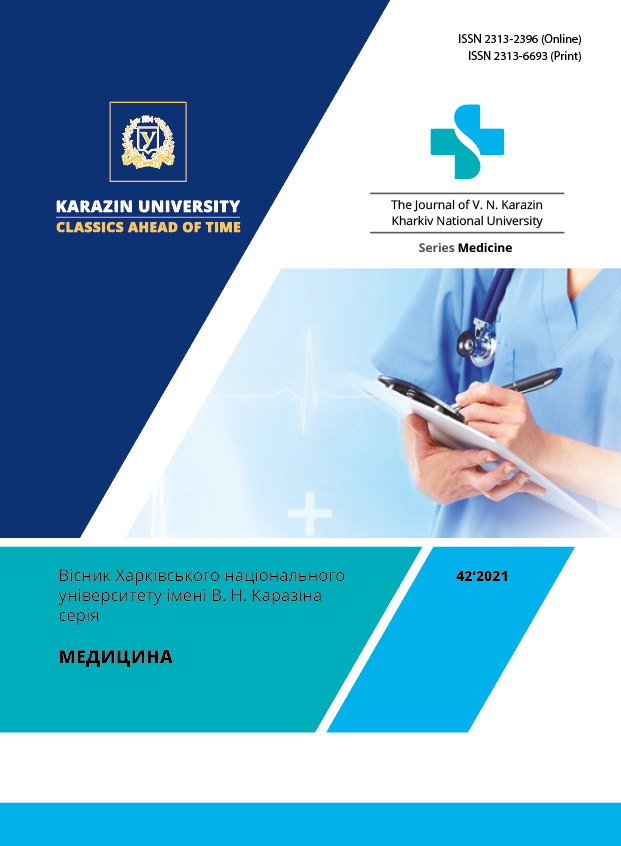Viscose and Thrombocytic-Aggrega-Tion Disorders On Patients With Myocardial Infarction With Stable Elementation of ST Segment
Abstract
Abstract. Clinical studies indicate a significant role in the pathogenesis of acute myocardial infarction, the functional state of platelet aggregation and blood viscosity, which determine the nature of blood flow in the vessels at the level of macro- and microcirculation. The aim of the study was to analyze changes in viscosity and platelet-aggregation disorders under the influence of different tactical, diagnostic and interventional approaches in patients with myocardial infarction and stable elevation of the ST segment in the presence of multivascular coronary artery disease. Materials and methods. The study used 4 tactical and treatment-diagnostic approaches during the year of observation. Results. Patients with myocardial infarction with persistent ST-segment elevation were found to have hyperviscosity and hypercoagulability syndromes, manifested in the first weeks by a compensatory increase in platelet count, blood viscosity, fibrinogen levels, and an increase in platelet aggregation. Conclusions. Carrying out additional in-depth examination of coronary circulation (coherent tomography and intravascular sonography) as the main methods of detailed assessment of atheromatous process and further application of delayed stenting of infarct-independent arteries in group 1, contributed to lower amplitude of fluctuations, due to the systemic step-by-step improvement of arterial blood supply, to optimize the state of viscosity and processes of adhesion / aggregation of platelets. Traditional tactical and medical-diagnostic principles of this category of patients do not allow to fundamentally improve the state of viscosity and coagulation-aggregation parameters, even with the use of dual antiplatelet therapy.
Downloads
References
Gabbasov ZA. Platelet phenotype and myocardial infarction. Creative Cardiology. 2014; 2: 48–59 [in Russian]. https://cardiology-journal.com/catalog/detail.php?SECTION_ID=971&ID=18348
Nikiforov VS. Blood viscosity as a target of therapeutic effects in cardiovascular pathology. Farmateka. 2015; 13: 59–62 [in Russian]. https://pharmateca.ru/en/archive/article/31900
Koryakina LB, Pivovarov YuI, Kurilskaya TE. Dysfunction of the vascular endothelium in arterial hypertension and coronary heart disease. Bulletin of the All-Russian Scientific Center of the Siberian Branch of the Russian Academy of Medical Sciences. 2013; 2 (90): 165–170 [in Russian]. https://www.actabiomedica.ru/jour/article/view/1550
Jagpal A, Navarro-Millán I. Cardiovascular co-morbidity in patients with rheumatoid arthritis: A narrative review of risk factors, cardiovascular risk assessment and treatment. BMC Rheumatology. 2018; 2 (1): 10. https://doi.org/10.1186/s41927-018-0014-y
Lysenko GI. The role of clopidogrel in the prevention of cardiovascular catastrophes. Mistake of Likuvannya. 2011; 3 (79): 58–63 [in Russian]. https://www.health-medix.com/articles/misteztvo/2011-04-11/11GILSSK.pdf
Bonin M, Mewton N, Roubille F, Boussaha I, Derumeaux G. Effect and safety of morphine use in acute anterior ST-segment elevation myocardial infarction. Journal of the American Heart Association. 2018; 7 (4): e006833. https://doi.org/10.1161/JAHA.117.006833
Harrington DH, Stueben F, Lenahan CM. ST-elevation myocardial infarction and non-ST-elevation myocardial infarction: Medical and surgical interventions. Critical Care Nursing Clinics of North America. 2019; 31 (1): 49–64. https://doi.org/10.1016/j.cnc.2018.10.002
Baek JY, Kang TS, Rha S-W, Park SH, Jeong MH. Twelve-month clinical outcomes of acute non-ST versus ST-segment elevation myocardial infarction patients with reduced preprocedural thrombolysis in myocardial infarction flow undergoing percutaneous coronary intervention. Coronary Artery Disease. 2018; 29 (5): 416–422. https://doi.org/10.1097/MCA.0000000000000632.
Thygesen K, Alpert JS, Jaffe AS, Chaitman BR, Bax JJ, Morrow DA, White HD, Parkhomenko A. Fourth universal definition of myocardial infarction. Circulation. 2018; 138 (20): e618-e651. https://www.acc.org/latest-in-cardiology/ten-points-to-remember/2018/08/24/00/09/fourth-universal-definition-of-mi-esc-2018
Yang S-H, Du Y, Zhang Y, Sun J, Li J-J. Serum fibrinogen and cardiovascular events in Chinese patients with type 2 diabetes and stable coronary artery disease: A prospective observational study. British Medical Journal. 2017; 7 (6): 123–125. https://bmjopen.bmj.com/content/7/6/e015041
Parizadeh SM, Jafarzadeh-Esfehani R, Ghandehari M, Parizadeh MR, Ferns GA, Avan A, Hassanian SM. Stem cell therapy: A novel approach for myocardial infarction. Journal of Cellular Physiology. 2019; 234 (10): 16904–16912. https://doi.org/10.1002/jcp.28381
Pandey AK, Duong T, Swiatkiewicz I, Daniels LB. A comparison of biomarker rise in type 1 and type 2 myocardial infarction. American Journal of Medicine. 2020; 133 (10): 1203–1208. https://doi.org/10.1016/j.amjmed.2020.02.024
András J, Gergely E, Péter PF, Péter O, Péter A. Prognostic significance of the total ischemic time in patients with ST-elevation myocardial infarction. Orvosi Hetilap. 2018; 159 (27): 1113–1120. https://doi.org/10.1556/650.2018.31108
Caimi G, Hopps E, Montana M, Canino B, Lo Presti R. Analysis of the blood viscosity behavior in the Sicilian study on juvenile myocardial infarction. Clinical and Applied Thrombosis/Hemostasis. 2018; 24 (8): 1276–1281. https://doi.org/10.1177/1076029618775511
Clemetson KJ. Platelet receptors. In: A.D. Michelson (Ed.), Platelets (pp. 169–194). San Diego: Elsevier Academic Press; 2013.
The Journal of V. N. Karazin Kharkiv National University, series Medicine has following copyright terms:
- Authors retain copyright and grant the journal right of first publication with the work simultaneously licensed under a Creative Commons Attribution License that allows others to share the work with an acknowledgement of the work’s authorship and initial publication in this journal.
- Authors are able to enter into separate, additional contractual arrangements for the non-exclusive distribution of the journal’s published version of the work, with an acknowledgement of its initial publication in this journal.
- Authors are permitted and encouraged to post their work online prior to and during the submission process, as it can lead to productive exchanges, as well as earlier and greater citation of published work.




